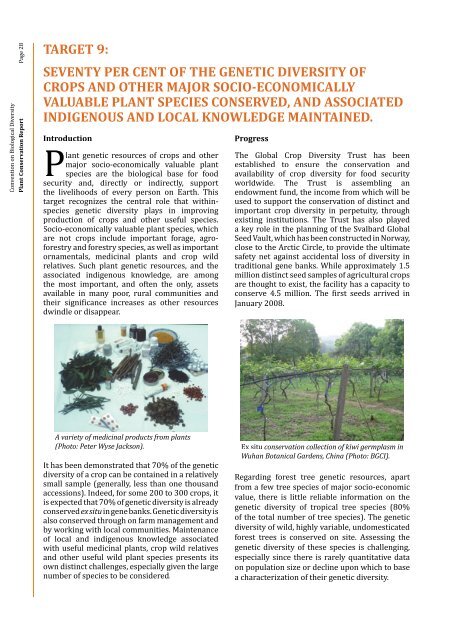from the global partnership for plant conservation
from the global partnership for plant conservation
from the global partnership for plant conservation
Create successful ePaper yourself
Turn your PDF publications into a flip-book with our unique Google optimized e-Paper software.
Convention on Biological DiversityPlant Conservation Report Page 28TARGET 9:SEVENTY PER CENT OF THE GENETIC DIVERSITY OFCROPS AND OTHER MAJOR SOCIO-ECONOMICALLYVALUABLE PLANT SPECIES CONSERVED, AND ASSOCIATEDINDIGENOUS AND LOCAL KNOWLEDGE MAINTAINED.IntroductionPlant genetic resources of crops and o<strong>the</strong>rmajor socio-economically valuable <strong>plant</strong>species are <strong>the</strong> biological base <strong>for</strong> foodsecurity and, directly or indirectly, support<strong>the</strong> livelihoods of every person on Earth. Thistarget recognizes <strong>the</strong> central role that withinspeciesgenetic diversity plays in improvingproduction of crops and o<strong>the</strong>r useful species.Socio-economically valuable <strong>plant</strong> species, whichare not crops include important <strong>for</strong>age, agro<strong>for</strong>estryand <strong>for</strong>estry species, as well as importantornamentals, medicinal <strong>plant</strong>s and crop wildrelatives. Such <strong>plant</strong> genetic resources, and <strong>the</strong>associated indigenous knowledge, are among<strong>the</strong> most important, and often <strong>the</strong> only, assetsavailable in many poor, rural communities and<strong>the</strong>ir signiicance increases as o<strong>the</strong>r resourcesdwindle or disappear.ProgressThe Global Crop Diversity Trust has beenestablished to ensure <strong>the</strong> <strong>conservation</strong> andavailability of crop diversity <strong>for</strong> food securityworldwide. The Trust is assembling anendowment fund, <strong>the</strong> income <strong>from</strong> which will beused to support <strong>the</strong> <strong>conservation</strong> of distinct andimportant crop diversity in perpetuity, throughexisting institutions. The Trust has also playeda key role in <strong>the</strong> planning of <strong>the</strong> Svalbard GlobalSeed Vault, which has been constructed in Norway,close to <strong>the</strong> Arctic Circle, to provide <strong>the</strong> ultimatesafety net against accidental loss of diversity intraditional gene banks. While approximately 1.5million distinct seed samples of agricultural cropsare thought to exist, <strong>the</strong> facility has a capacity toconserve 4.5 million. The irst seeds arrived inJanuary 2008.A variety of medicinal products <strong>from</strong> <strong>plant</strong>s(Photo: Peter Wyse Jackson).It has been demonstrated that 70% of <strong>the</strong> geneticdiversity of a crop can be contained in a relativelysmall sample (generally, less than one thousandaccessions). Indeed, <strong>for</strong> some 200 to 300 crops, itis expected that 70% of genetic diversity is alreadyconserved ex situ in gene banks. Genetic diversity isalso conserved through on farm management andby working with local communities. Maintenanceof local and indigenous knowledge associatedwith useful medicinal <strong>plant</strong>s, crop wild relativesand o<strong>the</strong>r useful wild <strong>plant</strong> species presents itsown distinct challenges, especially given <strong>the</strong> largenumber of species to be considered.Ex situ <strong>conservation</strong> collection of kiwi germplasm inWuhan Botanical Gardens, China (Photo: BGCI).Regarding <strong>for</strong>est tree genetic resources, apart<strong>from</strong> a few tree species of major socio-economicvalue, <strong>the</strong>re is little reliable in<strong>for</strong>mation on <strong>the</strong>genetic diversity of tropical tree species (80%of <strong>the</strong> total number of tree species). The geneticdiversity of wild, highly variable, undomesticated<strong>for</strong>est trees is conserved on site. Assessing <strong>the</strong>genetic diversity of <strong>the</strong>se species is challenging,especially since <strong>the</strong>re is rarely quantitative dataon population size or decline upon which to basea characterization of <strong>the</strong>ir genetic diversity.
















